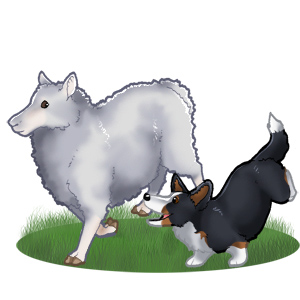Train
Information
Herding (H)

Sport Stat Weights
x2 Agility (agi)x1 Charisma (cha)x2 Intelligence (int)x1 Speed (spd)x2 Stamina (stm)x1 Strength (str)This sport is restricted to certain breeds.
Description
Herding competitions are often called herding trials. In these trials, dogs have to move sheep around a field, often through gates, fences, and into and out of enclosures as directed by their handlers. Some trials contain a pair of dogs being used, called a “brace,” while others involve only one dog. Trials like these have been around for hundreds of years.
In a basic herding trial, one dog and its handler move three to six sheep through the given course. The pair is penalized if a sheep stray or move too slowly. The handler can even be penalized on giving too few commands, or even too many. Generally, the shepherd directs the dog by whistled commands, especially when the dog is far away. Vocal commands are also used. Some of the common vocal commands are “Away to Me,” which means go counterclockwise around the stock, “Come Bye,” which means go clockwise around the stock, “Take Time,” which means back off of the stock, and “Lie Down,” which requires the dog to stop immediately. Many events are timed and each exercise is marked by judges.
Dogs often must work hundreds of yards away from their handlers, sometimes slipping out of sight because of the lay of the land. When this happens, the only way the handler can know where the dog is located is by watching the sheep. In fact, this sport has as much to do with managing a dog as with learning to read and manage livestock. The handler must stay close to what’s called the “post” until the dog has “fetched” the sheep through a series of fences. Once the portion of the trial is reached where the sheep must be pushed into a small pen, the handler is allowed to leave the post to manage the pen gate. In the “penning” part of the trial, the dog must manage to push the livestock into a pen. The handler is not allowed to touch the sheep in any way, but often, when the dog is positioned just right and the sheep are balking at the pen entrance, a handler will attempt to scare the sheep into the pen by jumping up and down, shouting, or waving his or her cap.
Another part of a trial, most often present in the top level of herding trials -- the Open level -- is called “shedding.” In shedding, the dog must split specified sheep from the flock and keep them separated. This is difficult as sheep instinctively want to stay together. The handler is again allowed to leave the post but may not touch the sheep.
Herding competitions have always attracted the interest of the media and many spectators. It is one of the better known dog sports and appeals to both the handlers and the spectators also. Many books have been written, fiction and non-fiction about this sport.
Written By: Ancien (#66610)
Edited By: Kahlem (#1)
In a basic herding trial, one dog and its handler move three to six sheep through the given course. The pair is penalized if a sheep stray or move too slowly. The handler can even be penalized on giving too few commands, or even too many. Generally, the shepherd directs the dog by whistled commands, especially when the dog is far away. Vocal commands are also used. Some of the common vocal commands are “Away to Me,” which means go counterclockwise around the stock, “Come Bye,” which means go clockwise around the stock, “Take Time,” which means back off of the stock, and “Lie Down,” which requires the dog to stop immediately. Many events are timed and each exercise is marked by judges.
Dogs often must work hundreds of yards away from their handlers, sometimes slipping out of sight because of the lay of the land. When this happens, the only way the handler can know where the dog is located is by watching the sheep. In fact, this sport has as much to do with managing a dog as with learning to read and manage livestock. The handler must stay close to what’s called the “post” until the dog has “fetched” the sheep through a series of fences. Once the portion of the trial is reached where the sheep must be pushed into a small pen, the handler is allowed to leave the post to manage the pen gate. In the “penning” part of the trial, the dog must manage to push the livestock into a pen. The handler is not allowed to touch the sheep in any way, but often, when the dog is positioned just right and the sheep are balking at the pen entrance, a handler will attempt to scare the sheep into the pen by jumping up and down, shouting, or waving his or her cap.
Another part of a trial, most often present in the top level of herding trials -- the Open level -- is called “shedding.” In shedding, the dog must split specified sheep from the flock and keep them separated. This is difficult as sheep instinctively want to stay together. The handler is again allowed to leave the post but may not touch the sheep.
Herding competitions have always attracted the interest of the media and many spectators. It is one of the better known dog sports and appeals to both the handlers and the spectators also. Many books have been written, fiction and non-fiction about this sport.
Written By: Ancien (#66610)
Edited By: Kahlem (#1)
Allowed Breeds
Aidi, Akbash Dog, American White Shepherd, Anatolian Shepherd, Appenzeller Mountain Dog, Australian Cattle Dog, Australian Koolie, Australian Shepherd, Azores Cattle Dog, Bearded Collie, Beauceron, Belgian Laekenois, Belgian Malinois, Belgian Sheepdog, Belgian Tervuren, Berger Picard, Bernese Mountain Dog, Black Mouth Cur, Border Collie, Bouvier des Flandres, Briard, Canaan Dog, Cardigan Welsh Corgi, Carpathian Shepherd, Catahoula Leopard Dog, Caucasian Ovtcharka, Central Asian Shepherd, Croatian Sheepdog, Czechoslovakian Wolfdog, Dogue de Bordeaux, Dutch Shepherd, English Shepherd, Finnish Lapphund, German Shepherd Dog, Giant Schnauzer, Great Pyrenees, Greater Swiss Mountain Dog, Hovawart, Icelandic Sheepdog, Kelpie, Komondor, Kuvasz, Lapponian Herder, Leonberger, Maremma Sheepdog, Miniature Australian Shepherd, Mudi, Norwegian Buhund, Old English Sheepdog, Pembroke Welsh Corgi, Puli, Rottweiler, Rough Collie, Saarloos Wolfdog, Samoyed, Shetland Sheepdog, Smooth Collie, Swedish Vallhund, Tibetan Mastiff


